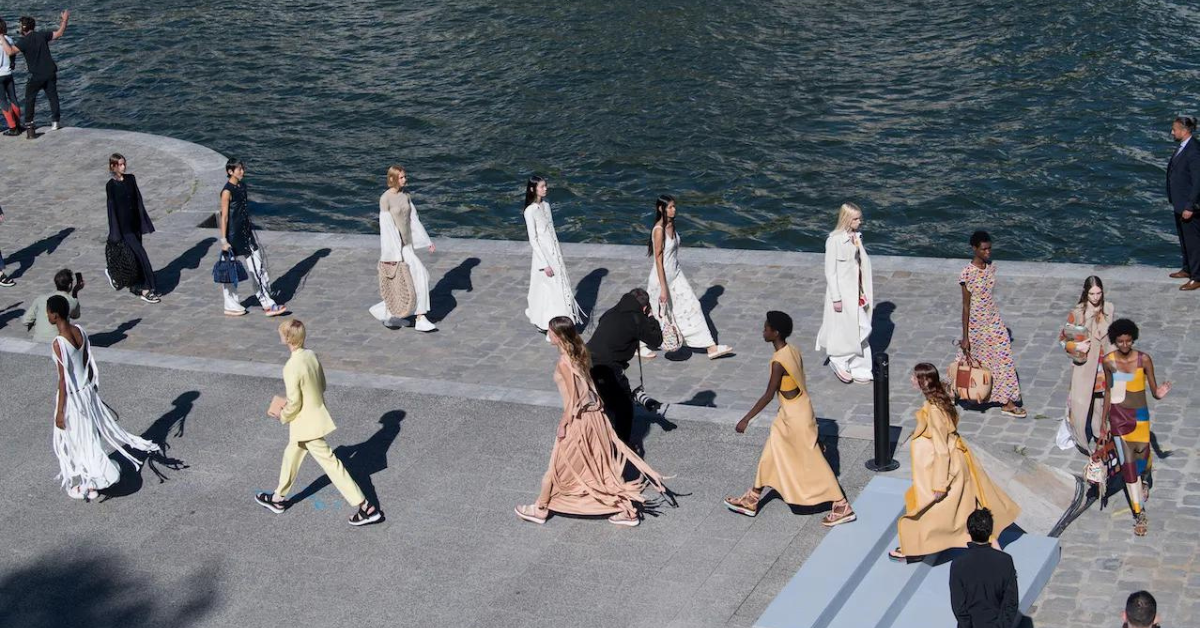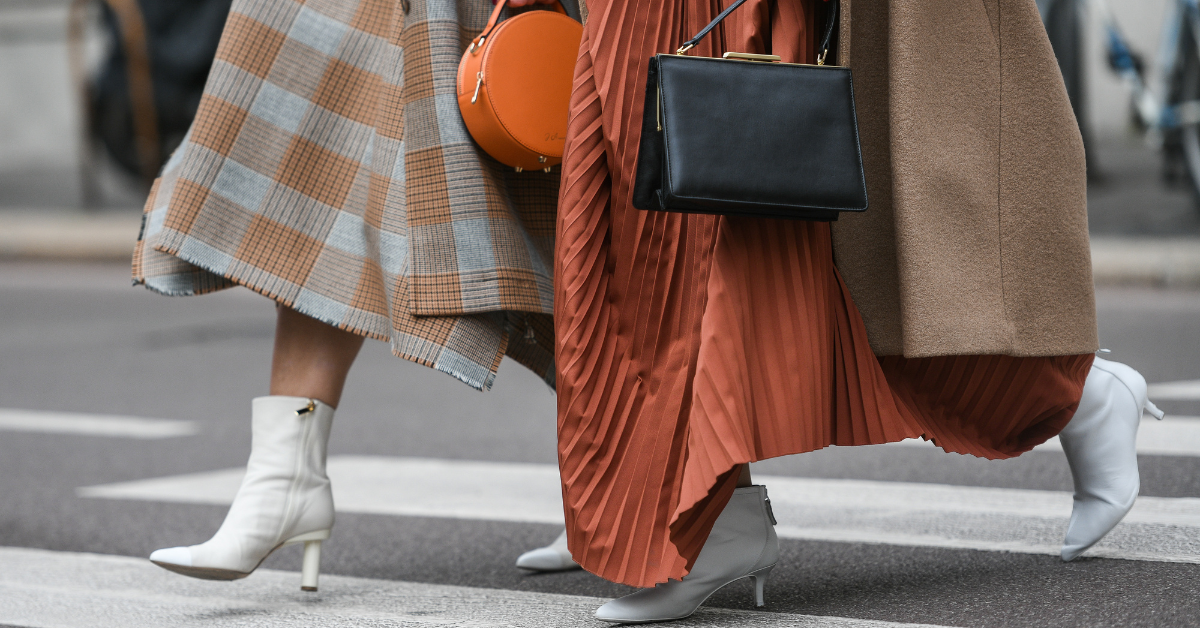
On a beautiful fall afternoon when designer Gabriela Hearst held her first in-person show for Chloé, along the banks of the Seine, unknowingly it became a pivotal moment for sustainability and inclusivity in fashion. A full 360, where not only the collection was made with sustainable materials, but guests were seated on cushions made of Chloé fabric remnants, atop benches of stacked bricks, constructed by Les Bâtisseuses, a network that trains women refugees.
Like art for the soul, luxury fashion tells a story of skill, heritage, and being exclusive. It’s changed a lot over the years, adapting to society and new influences. From fancy Paris runways to accessible ready-to-wear fashion, it keeps reinventing while staying exclusive and charming.
Zooming out from the enchanting world of sustainable luxury, it is important to note the dynamic comparison between luxury fashion and the fast-paced trends of the fashion industry.
Fast fashion vs slow fashion
With the rise of the digital world and social media, fashion trends have surpassed being limited to the place of origin, they are now global. With this rise, came the rise of fast fashion and e-commerce to cover up the gap in the market for the demands of global trends. While this gap is being filled in almost real-time, 69% of fast fashion is produced using synthetic/plastic fibres like polyester which can take over two decades to decompose. Unfortunately, only about 15% of these discarded clothes and materials are recycled or donated while the remaining end up in landfills or are incinerated. Additionally, fast fashion practices promote unsafe working environments for the labour that is employed to produce clothes at lightning speed to constantly keep up with trends.
However, while this age is marked by digital and media, it is also marked by environmental consciousness, pushing sustainability to become a driving force in the luxury fashion industry. Consumers now are aware and prioritise, more than ever, ethically produced goods, both through practices and materials. With this change in consumer demands, brands now, are implementing eco-friendly practices through organic or recycled materials, adopting renewable energy sources, ethical manufacturing processes and even through sustainable packaging alternatives. This alignment of brands demonstrates the commitment of luxury fashion brands towards social responsibility and wanting to resonate with consumers who are actively seeking meaningful and environmentally conscious choices.
Sustainability doesn’t necessarily mean compromise. “Much of the industry is catering to fast fashion and sustainability only gets difficult when the quantities are inadequate in comparison to the demand. The difficult part of adopting sustainability is always the start of the process, however once it becomes a part of the brand rubric, it’s a structured and streamlined process”, says Ruchika Sachdeva, founder of Bodice, a fashion brand making waves in sustainable Indian fashion for the last 10 years.
Platforms and green giants transforming the fashion space
While prioritising sustainability is crucial, it’s equally essential for luxury fashion brands to embrace transparency, authenticity, and genuineness in their practices. Different brands are approaching this in multiple ways, multiple initiatives worldwide are enabling brands to reach their consumers and allowing more accessibility in the processes involved in the creation of a luxury product. Platforms like Aura, the world’s very first global luxury blockchain, allows consumers to follow the entire lifecycle of a product by simply scanning the label of a product they wish to buy. Lab-grown diamonds and sustainable leather alternatives made from plant-based sources are becoming increasingly common in fashion collections.
View this post on Instagram
The Fashion Pact, a collaboration between luxury brands and sustainable initiatives, was born out of the recognition that only collective action can change the environmentally harmful impact of the highly fragmented fashion industry. They have been working towards mitigating climate change through the implementation of Science Based Targets for Climate to achieve net-zero by 2050, restoring biodiversity by adopting strategies aligned with Science Based Targets for Nature, and protecting oceans and freshwater from the industry’s negative impact through solutions that address pollution from upstream textile production and plastic packaging.
Brands you know of, taking the sustainable route
While many brands are on their way to adopt sustainable practices, there are many that have been successful in setting examples as brands that are socially and environmentally accountable.
Stella McCartney
View this post on Instagram
The brand is committed to using sustainable and alternative materials, such as Mylo, a mushroom-based substitute for traditional leather. The designer also emphasises the importance of circular fashion by extending the life of products through recycling and resale initiatives, like TheRealReal. Furthermore, the designer advocates for regenerative farming practices to enhance biodiversity and soil health.
Anita Dongre
View this post on Instagram
Grassroot—an exclusive label introduced by the designer features ethically produced sustainable clothing. This initiative not only supports but also empowers female artisans from rural communities, preserving and promoting traditional Indian crafts such as intricate threadwork, hand-embroidery, and time-honoured dyeing techniques.
The House of Anita Dongre demonstrates its dedication to sustainability through the use of biodegradable and compostable fibres like BembergTM and TencelTM, along with cotton sourced from the Better Cotton Initiative.
Gucci
View this post on Instagram
Pioneering the use of ECONYL, a fabric crafted from recycled consumer waste, discarded carpets, and ghost fishnets, Gucci demonstrates a steadfast commitment to environmental standards. The brand employs sustainable materials like chrome-free tanned leather, recycled polyester thread, and linings, as well as recycled brass, gold, and palladium hardware. Guaranteeing the traceability of 95% of its raw materials, Gucci stands out as one of the most transparent luxury brands. The brand’s dedication to eco-friendly practices is further exemplified through Gucci Equilibrium, a platform launched in 2015, aligning with the sustainable vision of its parent company, Kerring. Notably, 2020 witnessed the introduction of Off the Grid, Gucci’s inaugural sustainable collection, made from regenerated ECONYL in line with its 10 year sustainability plan projected till 2025.
Ritu Kumar
View this post on Instagram
Sustainability is woven into the DNA of Ritu Kumar. Presented at FDCI x Lakmé Fashion Week 2021 in partnership with TRESemmé, her spring/summer 2021 collection “Mismatched” showcased environmentally-friendly organic soya fabric saris inspired by nature. In her autumn/winter 2020/2021 collection, titled “Nature’s Origami,” Kumar collaborated with the sustainable fibre brand Lenzing Ecovero. Drawing inspiration from tribal and contemporary Indian art, as well as the work of the late sculptor Mrinalini Mukherjee, the collection showcases floral prints on textiles crafted from eco-friendly materials.
Bottega Venetta
View this post on Instagram
As early as 2012, the brand introduced a line of durable, timeless, and eco-friendly handbags, driven by the goal of reducing carbon emissions. Notably, the brand incorporated a robust, waterproof, and flexible material derived from Naoron paper, crafted from mulberry tree bark, and Japanese washi paper for this collection. Operating under the Kering Group, Bottega Veneta achieved a significant milestone in 2014 by becoming the first luxury label to attain LEED certification from the Green Building Council for its eco-friendly Montebello Vicentino atelier. During Milan 2020, the brand showcased a groundbreaking collection of biodegradable boots crafted from sugarcane and coffee. In 2022, the brand also announced a program called ‘Certificate of Craft’, stating certain iconic bags can be brought in for complimentary refresh and repair, acting as a lifetime warranty.
Diacolor
View this post on Instagram
In a conscious collaboration, DIACOLOR joined forces with philanthropist, environmentalist, and eco-artist Natalia Kapchuk, in April 2022, to highlight the marvels provided by Mother Nature. Through a range of unique mediums like resi-crete, reclaimed woods, plastic, metallic grit, natural stones, crystals, diamond dust, and more. These pieces compellingly convey the importance of appreciating, protecting, and raising awareness about the environment, showcasing the need for environmental consciousness.
The flip side
However, the flip side of the coin is to keep in mind that while brands may be working with biomaterials and vegan leathers among other sustainable materials, that is commonly part of a capsule collection, and not necessarily for the entire brand. With the price points of using sustainable materials and the consequent drop in profit margins for most brands, the use and production of sustainable materials is not scalable, as of yet. According to Kriti Tula, Creative Director and Founder of Indian fashion brand, Doodlage, simply shrugging shoulders, putting new ideas under the rug over quality and lack of a supply chain is no longer an option, there is dire need for more commitment to move to alternatives.
Can luxury brands ever go 100% green?
Director of Jaipur Rugs, Yogesh Chaudhary believes that it’s definitely possible. As it’s well known, the world follows luxury so once luxury fashion brands prioritise sustainability, it will trickle down eventually. There is a positive projection for the same, with brands like Kerring taking initiatives with their sustainability index and with Apple also looking at hopefully eliminating and reversing their carbon impact.
The ultimate difference makers
Environmental consciousness in luxury fashion may not remain a mere choice in years to come. “The challenge lies in education on sustainability, without using jargon, without it being complicated”, says Akaaro’s founder, Gaurav Jai Gupta. As individuals engage in consumer decisions, the journey of self-education often begins with fostering curiosity and a genuine desire to expand knowledge. With the rise of OTT platforms like Netflix, accessing impactful documentaries has become more convenient, offering visual narratives that enhance understanding. An exclusive chat with industry experts, there are certain key aspects that consumers are encouraged to examine when making sustainable purchasing decisions, including enquiring about the materials and fabrics used, the ethical employment practices of a brand, the craftsmanship involved in product stitching, and, naturally, the brand’s communication on social media platforms.

Photo: Creative Lab/Shutterstock
Ultimately, in the words of sustainability expert, Saachi Bahl, “Consumers wield the real power for change. It is the consumers who tell brands what they want, how they want it and what they are genuinely willing to invest in! As more people begin embracing conscious fashion, brands are going to be compelled to cater to this demand.”

